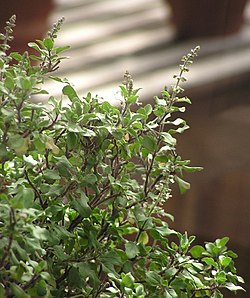Basil cultivars





| Ocimum basilicum cultivars | ||
|---|---|---|
| Common name | Species and cultivars | Description |
| Sweet basil, Genovese basil, great basil | O. basilicum | With a strong clove scent when fresh. [14] |
| Lettuce leaf basil | O. basilicum 'Lettuce Leaf' | Has leaves so large they are sometimes used in salads. [15] |
| Mammoth basil | O. basilicum 'Mammoth' | Another large-leaf variety, stronger flavor than sweet Genovese. [16] |
| Genovese basil | O. basilicum 'Genovese Gigante' | Almost as popular as sweet basil, with similar flavor. [16] [17] [18] [19] |
| Nufar basil | O. basilicum 'Nufar F1' | Variety of Genovese resistant to fusarium wilt. |
| Spicy globe basil | O. basilicum 'Spicy Globe' | Grows in a bush form, very small leaves, strong flavor. [20] |
| Greek Yevani basil | O. basilicum 'Greek Yevani' | Organically grown version of Spicy globe basil. |
| Fino verde basil | O. basilicum piccolo | Small, narrow leaves, sweeter, less pungent smell than larger leaved varieties. [21] |
| Boxwood basil | O. basilicum 'Boxwood' | Grows tightly like boxwood, very small leaves, strong flavor, great for pestos. |
| Purple ruffles basil | O. basilicum 'Purple Ruffles' | Solid purple, rich and spicy and a little more anise-like than the flavor of Genovese Basil. |
| Magical Michael | O. basilicum 'Magical Michael' | Award-winning hybrid with an uncommon degree of uniformity, and nice flavor for culinary use. [22] |
| Dark opal basil | O. basilicum 'Purpurascens' | Award-winning variety, developed at the University of Connecticut in the 1950s. [23] |
| Red rubin basil | O. basilicum 'Purpurascens' 'Red Rubin' | Strong magenta color, similar flavor to sweet basil, also called Opal basil. [16] |
| Osmin purple basil | O. basilicum 'Osmin Purple' | Dark shiny purple with a jagged edge on the leaves, smaller leaves than red rubin. [24] |
| Cuban basil | O. basilicum | Similar to sweet basil, with smaller leaves and stronger flavor, grown from cuttings. [25] |
| Thai basil | O. basilicum var. thyrsiflorum | Called Ho-ra-pa (โหระพา) in Thai, gets its scent of licorice from estragole. [5] |
| 'Siam Queen' | O. basilicum var. thyrsiflorum 'Siam Queen' [26] | A named cultivar of Thai Basil |
| Cinnamon basil | O. basilicum 'Cinnamon' | Also called Mexican spice basil, with a strong scent of cinnamate, the same chemical as in cinnamon. Has purple flowers. [5] |
| Licorice basil | O. basilicum 'Licorice' | Also known as Anise basil or Persian basil, silvery leaves, spicy licorice smell comes from the same chemical as in anise, anethole. Thai basil is also sometimes called Licorice basil. [27] |
| White basil | O. basilicum var. pilosum | White and hairy branches/leaves and white flowers. Aromatic lemon scent. Called é in Vietnamese. |
| Mrs. Burns' Lemon | O. basilicum var. citriodora 'Mrs. Burns' Lemon' | Clean, aromatic lemon scent, similar to lemon basil. [26] |
| Ocimum americanum (formerly known as O. canum) cultivars | ||
| Common name | Species and cultivars | Description |
| Lemon basil | O. americanum [26] | Contains citral and limonene, therefore actually does smell very lemony, tastes sweeter. Originally, and sometimes still, called "hoary basil". Popular in Indonesia, where it is known as 'kemangi'. Also sometimes 'Indonesian basil'. |
| Lime basil | O. americanum | Similar to lemon basil. [24] |
| Ocimum ×citriodorum cultivars | ||
| Common name | Species and cultivars | Description |
| Greek column basil | O. × citriodorum 'Lesbos' | Columnar basil, can only be propagated from cuttings. [28] |
| Thai lemon basil | O. × citriodorum | Called mangluk (แมงลัก) in Thai. It has a citrus odor, with a distinct Lemon-balm-like flavor [5] |
| Other species and hybrids | ||
| Common name | Species and cultivars | Description |
| Holy basil | O. sanctum (alt. O. tenuiflorum) | Also sacred basil, Tulsi (तुलसी) in Hindi, a perennial breed from India, used in Ayurveda, for worship, and in Thai cooking. [5] Called kaphrao (กะเพรา) in Thai. |
| Clove Basil | O. gratissimum | |
| Greek basil (Greek spicy globe Basil) | O. minimum (alt. O. basilicum var. minimum) | Forms a nearly perfectly round globe, with thin, tiny leaves and a delicious scent. Despite its name, the variety probably originated in Chile. [29] [30] |
| Dwarf bush basil | O. minimum | Unusually small bush variety, similar to Greek bush basil. [14] |
| African blue basil | O. kilimandscharicum × basilicum | A sterile perennial hybrid, with purple coloration on its leaves and containing a strong portion of actual camphor in its scent. [5] |
| Spice basil | O. basilicum × americanum | A fruity/musky-scented cultivar sometimes sold as Holy Basil |
| Sweet Dani basil | O. basilicum × americanum | A vigorous, large-leaved green basil with a strong, fresh lemon scent, [31] a 1998 All-American Selection. [32] |
| Camphor basil | O. kilimandscharicum | |